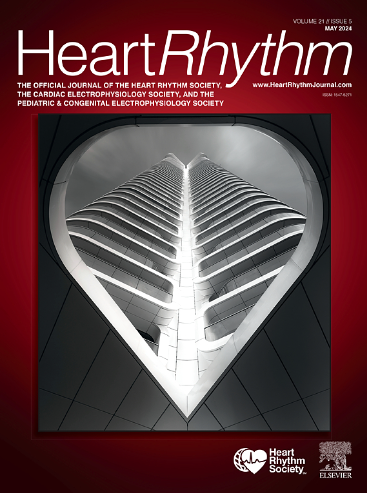右肋间动脉的临床解剖:肺静脉隔离术前需要了解的另一个邻居。
IF 5.7
2区 医学
Q1 CARDIAC & CARDIOVASCULAR SYSTEMS
引用次数: 0
摘要
背景:左心房(LA)后方的右肋间动脉(ICA)损伤导致的血胸是肺静脉隔离术中潜在的致命并发症。然而,它们之间的解剖关系尚未完全阐明:本研究旨在探讨右侧 ICA 与 LA 的临床解剖关系:这项回顾性研究纳入了 100 名接受心脏计算机断层扫描的患者(70.2 ± 10.6 岁,39.0% 为女性)。患者被分为窦性心律(SR)组和心房颤动(AF)组。我们重点研究了 LA 和右 ICAs 之间的距离及其预测因素:结果:平均有 3.7 ± 0.7 个右侧 ICAs 位于 LA 后方。其中,54%的病例中第八ICA距离最近,其次是29%的病例中第七ICA距离最近,14%的病例中第九ICA距离最近。它们之间的平均最近距离为 3.8 ± 3.8 毫米,房颤组明显短于 SR 组(3.0 ± 3.2 毫米 vs. 4.7 ± 4.2 毫米,P = 0.006)。多变量分析显示,较薄的胸腔(β = -0.512,p = 0.002)和 LA 扩张(β = -0.432,p = 0.001)是预测较短距离的因素。最近的点沿椎体分布,一般靠近下肺静脉口:结论:右侧 ICA-LA 近距离得到了系统性的明确。特别是在 LA 扩大和/或胸腔较薄的病例中,操作者应注意在肺静脉分离过程中损伤右 ICA 的潜在风险。本文章由计算机程序翻译,如有差异,请以英文原文为准。

Clinical anatomy of the right intercostal arteries: Another neighbor to know before pulmonary vein isolation
Background
Hemothorax caused by a right intercostal artery (ICA) injury behind the left atrium (LA) is a potentially fatal complication during pulmonary vein isolation. However, their anatomic relationship has not been fully elucidated.
Objective
This study aimed to investigate the clinical anatomy of the right ICA in relation to the LA.
Methods
This retrospective study included 100 patients (70.2 ± 10.6 years; 39.0% female) who underwent cardiac computed tomography. The patients were divided into sinus rhythm and atrial fibrillation groups. We focused on the distance between the LA and right ICAs and its predictive factors.
Results
On average, 3.7 ± 0.7 right ICAs were found behind the LA. Of these, the eighth ICA was the closest in 54% of the cases, followed by the seventh ICA in 29% and the ninth ICA in 14%. The average closest distance between them was 3.8 ± 3.8 mm, which was significantly shorter in the atrial fibrillation group than in the sinus rhythm group (3.0 ± 3.2 mm vs 4.7 ± 4.2 mm; P = .006). Multivariate analysis revealed that a thinner chest cavity (β = −0.512; P = .002) and LA dilation (β = −0.432; P = .001) were predictors of shorter distance. The closest points distributed along the vertebral column, generally near the inferior pulmonary vein orifices.
Conclusion
Right ICA-LA proximity was systematically clarified. Particularly in cases with an enlarged LA or thin chest cavity, operators should be aware of the potential risk of injuring the right ICA during pulmonary vein isolation.
求助全文
通过发布文献求助,成功后即可免费获取论文全文。
去求助
来源期刊

Heart rhythm
医学-心血管系统
CiteScore
10.50
自引率
5.50%
发文量
1465
审稿时长
24 days
期刊介绍:
HeartRhythm, the official Journal of the Heart Rhythm Society and the Cardiac Electrophysiology Society, is a unique journal for fundamental discovery and clinical applicability.
HeartRhythm integrates the entire cardiac electrophysiology (EP) community from basic and clinical academic researchers, private practitioners, engineers, allied professionals, industry, and trainees, all of whom are vital and interdependent members of our EP community.
The Heart Rhythm Society is the international leader in science, education, and advocacy for cardiac arrhythmia professionals and patients, and the primary information resource on heart rhythm disorders. Its mission is to improve the care of patients by promoting research, education, and optimal health care policies and standards.
 求助内容:
求助内容: 应助结果提醒方式:
应助结果提醒方式:


